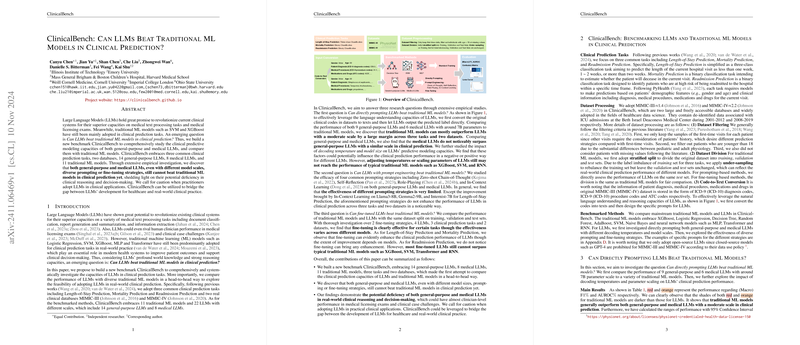Summary of ClinicalBench: A Comparative Analysis of LLMs and Traditional ML Models in Clinical Prediction
The paper "ClinicalBench: Can LLMs Beat Traditional ML Models in Clinical Prediction?" introduces ClinicalBench, a novel benchmark designed to rigorously evaluate the performance of both general-purpose and medical LLMs against traditional ML models in clinical predictive tasks. Given the increasing interest in applying LLMs to healthcare, this paper critically examines and compares their efficacy in clinical prediction tasks, specifically focusing on Length-of-Stay Prediction, Mortality Prediction, and Readmission Prediction.
Research Approach
The paper employed two considerable datasets, MIMIC-III and MIMIC-IV, which are extensively utilized in health data science for modeling intensive care unit (ICU) admissions. ClinicalBench incorporates 11 traditional ML models, including logistic regression, SVM, XGBoost, and neural network architectures such as MLP, Transformer, and RNN, and contrasts their performance with 22 LLMs consisting of 14 general-purpose and 8 medical-specific models. The LLMs are assessed under several configuration scenarios with varying parameter sizes, decoding temperatures, prompt engineering strategies, and fine-tuning approaches.
Key Findings
- Direct Prompting: Despite the theoretical advantages of LLMs’ extensive medical knowledge, the paper demonstrates that direct prompting methods result in LLMs underperforming compared to traditional ML models across all tasks. LLMs could not achieve the performance levels consistently exhibited by traditional models such as XGBoost and SVM.
- Prompt Engineering: Various sophisticated prompting strategies, such as Chain-of-Thought, Self-Reflection, and In-Context Learning, were scrutinized. Although methods like In-Context Learning showed some improvement under specific contexts, especially on Length-of-Stay Prediction, these strategies generally failed to significantly elevate LLMs’ performance to surpass traditional models.
- Fine-Tuning Efficacy: Fine-tuning LLMs yielded noticeable performance gains in certain tasks, particularly Length-of-Stay and Mortality Predictions. However, these gains were still insufficient to overtake the conventional ML methods' effectiveness. Interestingly, models like Gemma2-9B performed better in some contexts but lacked consistent dominance over traditional counterparts.
- Impact of Parameter Scale and Temperature: Scaling up LLMs' parameters and adjusting decoding temperatures varied in effectiveness, suggesting that while expanding model capacity might enhance performance in specific instances, it does not ensure superior outcomes over traditional ML techniques in clinical predictions.
Implications and Considerations
The paper underscores the challenges of integrating LLMs into real-world clinical workflows due to their limitations in emulating clinical reasoning despite their promising strategic insights in medical knowledge assessments. Nevertheless, it highlights the need for further research to enhance LLMs’ ability to deal with the intricacies of healthcare data, possibly through the advances in data synthesis and emerging digital twin technologies.
Future Research Directions
To close the performance gap between LLMs and traditional ML models in clinical predictions, future research should explore deeper integration of contextually rich clinical data during model training phases while examining robust post-training methodologies tailored for healthcare. ClinicalBench emerges as a tool to facilitate ongoing advancements by offering a structured framework for testing emerging models across realistic healthcare scenarios.
In conclusion, while LLMs hold potential for transforming healthcare, ClinicalBench provides crucial insights into their current capabilities and impediments, cautioning practitioners about their limitations and emphasizing the reliability of traditional ML models in clinical applications.
